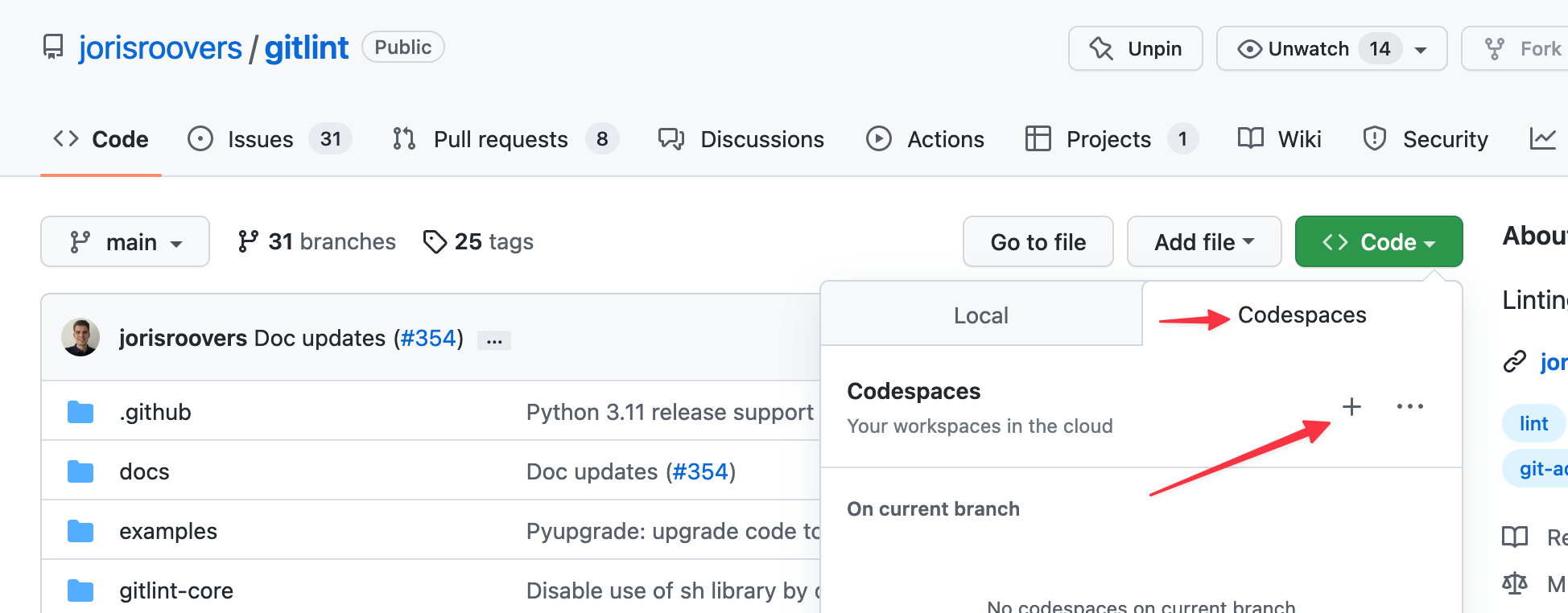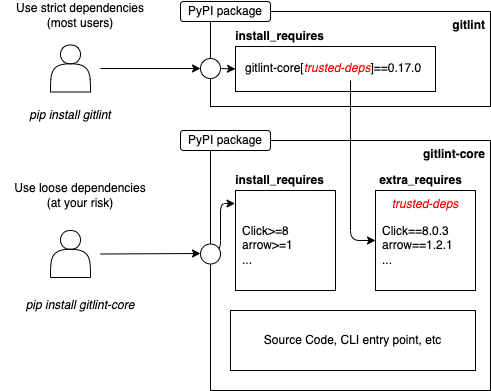9.3 KiB
Contributing
We'd love for you to contribute to gitlint. Thanks for your interest! The source-code and issue tracker are hosted on Github.
Often it takes a while for us (well, actually just me) to get back to you (sometimes up to a few months, this is a hobby project), but rest assured that we read your message and appreciate your interest! We maintain a loose project plan on github projects, but that's open to a lot of change and input.
Guidelines
When contributing code, please consider all the parts that are typically required:
- Unit tests (automatically enforced by CI). Please consider writing new ones for your functionality, not only updating existing ones to make the build pass.
- Integration tests (also automatically enforced by CI). Again, please consider writing new ones for your functionality, not only updating existing ones to make the build pass.
- Documentation.
Since we want to maintain a high standard of quality, all of these things will have to be done regardless before code can make it as part of a release. Gitlint commits and pull requests are gated on all of our tests and checks as well as code-review. If you can already include them as part of your PR, it's a huge timesaver for us and it's likely that your PR will be merged and released a lot sooner.
It's also a good idea to open an issue before submitting a PR for non-trivial changes, so we can discuss what you have in mind before you spend the effort. Thanks!
!!! Important On the topic of releases: Gitlint releases typically go out when there's either enough new features and fixes to make it worthwhile or when there's a critical fix for a bug that fundamentally breaks gitlint. While the amount of overhead of doing a release isn't huge, it's also not zero. In practice this means that it might take weeks or months before merged code actually gets released - we know that can be frustrating but please understand it's a well-considered trade-off based on available time.
Local setup
To install gitlint for local development:
python -m venv .venv
. .venv/bin/activate
pip install -r requirements.txt -r test-requirements.txt -r doc-requirements.txt
python setup.py develop
Github Devcontainer
We provide a devcontainer on github to make it easier to get started with gitlint development using VSCode.
To start one, click the plus button under the Code dropdown on the gitlint repo on github.
It can take ~15min for all post installation steps to finish.
After setup has finished, you should be able to just activate the virtualenv in the home dir and run the tests:
. ~/.venv/bin/activate
./run_tests.sh
By default we have python 3.11 installed in the dev container, but you can also use asdf (preinstalled) to install additional python versions:
# Ensure ASDF overrides system python in PATH
# You can also append this line to your ~/.bash_profile in the devcontainer to have this happen automatically on login
source "$(brew --prefix asdf)/libexec/asdf.sh"
# Install python 3.9.15
asdf install python 3.9.15
# List all available python versions
asdf list all python
# List installed python versions
asdf list python
Running tests
./run_tests.sh # run unit tests and print test coverage
./run_tests.sh gitlint-core/gitlint/tests/rules/test_body_rules.py::BodyRuleTests::test_body_missing # run a single test
pytest -k test_body_missing # Alternative way to run a specific test by invoking pytest directly with a keyword expression
./run_tests.sh --no-coverage # run unit tests without test coverage
./run_tests.sh --collect-only --no-coverage # Only collect, don't run unit tests
./run_tests.sh --integration # Run integration tests (requires that you have gitlint installed)
./run_tests.sh --build # Run build tests (=build python package)
./run_tests.sh --format # format checks (black)
./run_tests.sh --stats # print some code stats
./run_tests.sh --git # inception: run gitlint against itself
./run_tests.sh --lint # run pylint checks
./run_tests.sh --all # Run unit, integration, format and gitlint checks
Formatting
We use black for code formatting. To use it, just run black against the code you modified:
black . # format all python code
black gitlint-core/gitlint/lint.py # format a specific file
Documentation
We use mkdocs for generating our documentation from markdown.
To use it:
pip install -r doc-requirements.txt # install doc requirements
mkdocs serve
Then access the documentation website on http://localhost:8000.
Packaging
Gitlint consists of 2 python packages: gitlint and gitlint-core.
The gitlint package is just a wrapper package around gitlint-core[trusted-deps] which strictly pins gitlint
dependencies to known working versions.
There are scenarios where users (or OS package managers) may want looser dependency requirements.
In these cases, users can just install gitlint-core directly (pip install gitlint-core).
Issue 162 has all the background of how we got to the decision to split gitlint in 2 packages.
Packaging description
To see the package description in HTML format
pip install docutils
export LC_ALL=en_US.UTF-8
export LANG=en_US.UTF-8
python setup.py --long-description | rst2html.py > output.html
Tools
We keep a small set of scripts in the tools/ directory:
tools/create-test-repo.sh # Create a test git repo in your /tmp directory
tools/windows/create-test-repo.bat # Windows: create git test repo
tools/windows/run_tests.bat # Windows run unit tests
Contrib rules
Since gitlint 0.12.0, we support Contrib rules: community contributed rules that are part of gitlint itself. Thanks for considering to add a new one to gitlint!
Before starting, please read all the other documentation on this page about contributing first. Then, we suggest taking the following approach to add a Contrib rule:
- Write your rule as a user-defined rule. In terms of code, Contrib rules are identical to user-defined rules, they just happen to have their code sit within the gitlint codebase itself.
- Add your user-defined rule to gitlint. You should put your file(s) in the gitlint/contrib/rules directory.
- Write unit tests. The gitlint codebase contains Contrib rule test files you can copy and modify.
- Write documentation. In particular, you should update the gitlint/docs/contrib_rules.md file with details on your Contrib rule.
- Create a Pull Request: code review typically requires a bit of back and forth. Thanks for your contribution!
Contrib rule requirements
If you follow the steps above and follow the existing gitlint conventions wrt naming things, you should already be fairly close to done.
In case you're looking for a slightly more formal spec, here's what gitlint requires of Contrib rules.
- Since Contrib rules are really just user-defined rules that live within the gitlint code-base, all the user-rule requirements also apply to Contrib rules.
- All contrib rules must have associated unit tests. We sort of enforce this by a unit test that verifies that there's a test file for each contrib file.
- All contrib rules must have names that start with
contrib-. This is to easily distinguish them from default gitlint rules. - All contrib rule ids must start with
CT(for LineRules targeting the title),CB(for LineRules targeting the body) orCC(for CommitRules). Again, this is to easily distinguish them from default gitlint rules. - All contrib rules must have unique names and ids.
- You can add multiple rule classes to the same file, but classes should be logically grouped together in a single file that implements related rules.
- Contrib rules should be meaningfully different from one another. If a behavior change or tweak can be added to an existing rule by adding options, that should be considered first. However, large god classes that implement multiple rules in a single class should obviously also be avoided.
- Contrib rules should use options to make rules configurable.

